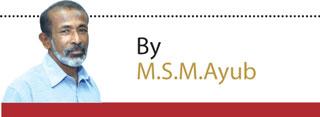Leaders of the Govt and parties like the NFF vilify Aragalaya and blame the economic crisis on the protestors – indicating their inability to realize the situation on the ground
 There was a highly tense situation in the country exactly a year ago with hundreds of thousands of people protesting against the Government across the country and especially in a permanent protest site at the Galle Face Green obstructing the main entrance of the Presidential Secretariat.
There was a highly tense situation in the country exactly a year ago with hundreds of thousands of people protesting against the Government across the country and especially in a permanent protest site at the Galle Face Green obstructing the main entrance of the Presidential Secretariat.
Protestors were calling President Gotabaya Rajapaksa -who was blamed for an unprecedented economic and political crisis-to quit the office with a catchy slogan “Gota Go Home.”
The slogan in English was first moot by a group of people, the majority of whom belonged to the urban middle class during a spontaneous huge surprise protest on the night of March 31, last year in front of the President’s private residence in Mirihana.
Despite continuous protest campaigns at Galle Face being brutally suppressed by the Armed Forces on July 22, last year – a day after Ranil Wickremesinghe took oaths as the President – it had already ousted an Executive President from power. It also, interestingly made two traditional political parties that have been accusing each other of having destructive policies to jointly run the Government.
Then the question arises as to why Rajapaksa should be killed if he had been tamed by the conspirator
Now, the leaders of the government, whose actions led to the bankruptcy of the country and cause the mass uprising or the Aragalaya (Struggle), as it was called, are vilifying the agitations and the agitators.
State Minister Sanath Nishantha called the protestors Rasthiyadukarayo (lumpens), while some other leaders described them as terrorists and even Fascists.
Minister Prasanna Ranatunga always identifies the protestors as terrorists. Former Minister Namal Rajapaksa at a recent event said the collapse of the Gotabaya Rajapaksa Government was engineered as part of a conspiracy hatched since the defeat of the LTTE.
Former Minister and leader of the National Freedom Front (NFF) Wimal Weerawansa has a fancy story about Aragalaya. He says it was controlled by US Ambassador Julie Chung. For him, the Aragalaya was an international conspiracy. He insinuates that the conspirator was the US.
At the launch of his book titled Nine; The Hidden Story, which he claimed is an extensive investigative study on the inside story of the Galle Face protest, he says the US Ambassador pressurized the Speaker Mahinda Yapa Abeywardena to form an interim Government, which would have consisted of personalities like Field Marshal Sarath Fonseka and the Chief of Defence Staff General Shavendra Silva.
And he connects this purported plan to the Aragalaya by stating that Fonseka was the only politician welcomed by the protestors to the Galle Face protest site.
He says that under this international conspiracy President Gotabaya Rajapaksa was to be killed while saying in the same breath that Rajapaksa was controlled by US Ambassador.
Rajapaksa’s deepest desire was to enjoy retirement in the United States, he said, which one cannot reject.
“Therefore he had acted as the US Ambassador instructed” he argued.
Then the question arises as to why Rajapaksa should be killed if he had been tamed by the conspirator. Besides, Weerawansa wanted Rajapaksa to stay in power even after he was sacked by the latter from the Cabinet on March 3 last year.
One might recall that it was the leaders of the 11 small parties including the NFF that broke ranks with the government earlier that proposed an all-party interim government first, during a meeting with President Rajapaksa on April 1, last year.
Besides, when a brutal crackdown was unleashed against the protestors in July he said it was the protestors who paved the way for Rajapaksa who treated them humanely to leave office and for the repressive Wickremesinghe to take over. This showed his pain over the fall of the administration that he says was controlled by the US.
Not only are the leaders of the Government and parties like the NFF vilifying Aragalaya but also attempting to blame the economic crisis on the protestors. The Government leaders are also attempting to bring in repressive laws such as the proposed Anti-Terrorism Bill (ATB) to suppress any future agitation by the people.
Due to a lack of political leadership, direction and a final destination for Aragalaya, we, in an article published in the Daily Mirror on July 30, last year predicted that it would end up in nowhere.
However, it did not and does not mean that the mass protest emerged from nowhere or it was just an attempt by some political party or a foreign force to capture power, as the Government leaders attempt to say. It had a solid socioeconomic background.
Successive Governments for the past several decades had presented deficit budgets and filled the gap with borrowings from local and foreign sources. Against this backdrop, the COVID-19 pandemic had a huge impact on the country’s economy, especially the industries and services that earned foreign exchange.
Gotabaya Rajapaksa Government’s policies brought the situation to a head. The Government’s decision to implement a huge tax cut in 2019 took a heavy toll on the public coffers. The import ban on chemical fertilizer and agrochemicals almost destroyed the country’s agriculture including export crops.
They assigned a fixed value for the dollar while the rupee was fast depreciating which resulted in about USD 5.5 Billion being wasted, according to the Central Bank officials. The decision not to seek assistance from the IMF, the only option left with the Government two years ago to face the unprecedented foreign exchange crisis resulted in a huge shortage of fuel and cooking gas which in turn led to a political crisis.
The so-called economic experts in the Sri Lanka Podujana Peramuna (SLPP) who criticize these decisions now, remained tightlipped then for fear of losing privileges and perks.
With the foreign reserves depleting, the rupee heavily depreciated sending prices about threefold high. Many companies and institutions implemented a cut in their workforce and their salaries. The real value of the meagre income millions of families received plummeted to dangerous levels.
The destruction of agriculture resulted in a food crisis as well. The inability to import fuel and gas created multiple issues including miles-long and days-long queues and a thirteen-hour power cut for a day, heightening the frustration to a head. Children irrespective of their social status suffered immensely due to power cuts and transport issues. Education was one of the worst-hit sectors.
Clueless as to how to handle the situation, President Rajapaksa on Mach 7 appointed an 11-member Economic Council and on March 15 a 14-member Advisory Board to advise the council.
And the Advisory Board in turn suggested appointing a Technical Committee and an Experts Committee, apart from a legal and financing advisor to advise the Finance Minster on March 21.
Besides, the President taking advice from former President Maithripala Sirisena convened an All Party Conference on March 23. And taking advice from the 11 small parties that had by the time distanced themselves from the Government, he got his entire Cabinet to resign on April 3 in order to form an all-party interim Government. Yet, no solution came forth out of any of these actions.
Meanwhile, people who were frustrated to the core due to economic issues were also furious to hear about frauds by politicians such as the infamous sugar deal, garlic deal and liquid fertilizer deal.
Thus, it was the aggregate of all these that exploded as a spontaneous and somewhat violent protest near the President’s private residence and later as a continuous protest at Galle Face.
Yet, the Aragalaya was a visionless struggle. They wanted Gotabaya to go but did not have a strategy to install an alternative administration, instead. It was the Parliament which they called a corrupt institution that decided the next course of action. They mobilized the people for the uprising but did not have a process for vetting or controlling them, leaving room for killings, arson attacks and vandalism, which the government leaders are using now as a smokescreen to hide the real facts behind the protests.
If government leaders truly believe that the mass uprising was engineered by the Opposition or an outside force and not an outcome of the explosion of the frustration of the people that indicates their inability to realize the situation on the ground. You cannot solve a problem without accepting its existence.

